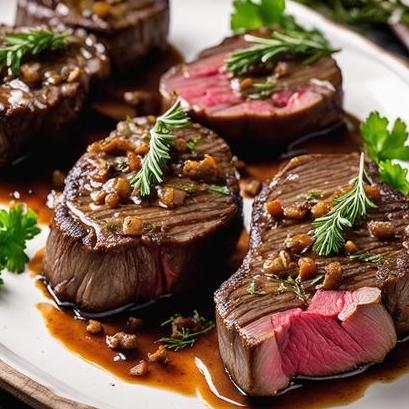
Venison Steaks Oven Recipe: A Comprehensive Guide
Welcome to this comprehensive guide on how to prepare delicious venison steaks in the oven. In this article, we will explore the food science behind venison, share culinary details on the meat, guide you through the selection and cleaning process, provide preparation tips, discuss variations of the recipe, and even cover essential doneness checks. So, let’s dive in and discover the art of cooking mouthwatering venison steaks!
The Science Behind Venison
Venison, the meat from deer, is renowned for its lean and flavorful characteristics. Compared to other red meats, it contains lower levels of fat and cholesterol. This makes it a healthy choice for those seeking a protein-packed meal.
Due to its gamey nature, venison boasts a unique flavor profile. It can be earthy, slightly sweet, and rich when cooked properly. Its texture is often tender, making it ideal for various preparations, including succulent steaks.
Culinary Details of Venison Steaks
Venison steaks are typically cut from the backstrap or tenderloin, the most tender and sought-after cuts. These cuts offer exceptional tenderness and flavor, making them the perfect choice for delightful steak dishes. However, you can also use other cuts, such as ribeye or sirloin, to prepare venison steaks.
The color of fresh venison is deep red, similar to beef. When cooked, it may turn slightly darker due to the absence of intramuscular fat. This makes it crucial to pay attention to cooking times to ensure optimal flavor and tenderness.
Selection and Cleaning

When selecting venison for steaks, ensure you choose high-quality, fresh cuts. Look for meat that is bright red with no signs of discoloration or strong odor. The texture should be firm and free from excessive moisture.
Before cooking, it is essential to clean the venison steaks thoroughly. Rinse them under cold water to remove any surface impurities, and gently pat them dry with paper towels. This process helps ensure a clean and safe cooking environment.
Preparing Venison Steaks for Cooking

Ingredients:
-
4 venison steaks (backstrap or tenderloin)
-
2 tablespoons of olive oil
-
2 cloves of garlic (minced)
-
1 tablespoon of fresh rosemary (chopped)
-
Salt and black pepper to taste
Steps:
-
Preheat your oven to 400°F (200°C). This temperature will provide a perfect balance between searing the steaks and cooking them to perfection.
-
Season the venison steaks generously with salt and black pepper on both sides, allowing the flavors to penetrate the meat.
-
In a skillet over medium-high heat, heat olive oil until shimmering. Add minced garlic and chopped rosemary, sautéing for about a minute to release their aromatic flavors.
-
Carefully place the seasoned venison steaks into the skillet, allowing them to sear for 2 minutes on each side. This process locks in the juices and creates a flavorful crust.
-
Transfer the steaks from the skillet to a baking dish lined with parchment paper. Insert a meat thermometer into the thickest part of one steak, ensuring it does not touch the bone or the bottom of the dish.
-
Place the dish in the preheated oven and bake for approximately 8-10 minutes, or until the internal temperature reaches your desired level of doneness. For a medium-rare finish, aim for an internal temperature of 130°F (54°C). Adjust cooking times accordingly for your preferred level of doneness.
Tips for Cooking Perfect Venison Steaks

-
Marinating: Consider marinating your venison steaks for a few hours before cooking. A marinade can enhance tenderness and add flavor to the meat. Opt for options like red wine, garlic, herbs, and soy sauce for an extra touch of deliciousness.
-
Resting Time: Allow the venison steaks to rest for 5-10 minutes after cooking. Resting the meat helps redistribute the juices, ensuring juicier and more tender steaks. Cover them with foil while resting to retain heat.
-
Sauces and Accompaniments: Pair your venison steaks with flavorful sauces like red wine reduction, cranberry glaze, or mushroom gravy. Serve them alongside roasted vegetables, creamy mashed potatoes, or wild rice for a well-rounded and satisfying meal.
Variations of Venison Steak Recipe

1. Bacon-Wrapped Venison Steaks
-
Wrap each venison steak with a slice of bacon, securing it with toothpicks or kitchen twine. This additional fat layer adds extra moisture and flavor to the lean venison meat.
-
Follow the same seasoning and cooking steps as mentioned above, adjusting the cooking time as necessary to ensure the bacon is cooked to your desired crispness.
2. Blackberry Glazed Venison Steaks
-
Prepare a blackberry glaze by simmering fresh or frozen blackberries in a saucepan with a dash of sugar and a squeeze of lemon juice. Cook until it thickens to your desired consistency.
-
Once the venison steaks are cooked as per the main recipe, brush them generously with the blackberry glaze before serving. The combination of sweet and savory flavors will elevate your dining experience.
Experiment with different flavors and ingredients to find your personal preference and create a signature venison steak recipe that’s uniquely yours.
Checking for Doneness
To ensure your venison steaks reach the desired level of doneness, use a meat thermometer and refer to the following internal temperature guide:
-
Rare: 120°F (49°C)
-
Medium-Rare: 130°F (54°C)
-
Medium: 140°F (60°C)
-
Medium-Well: 150°F (66°C)
-
Well Done: 160°F (71°C)
Remember that venison is leaner than beef, so overcooking may result in dry and tough steaks. It is advisable to use a meat thermometer to guarantee perfect results every time.
Conclusion
Cooking venison steaks in the oven is a fantastic way to elevate your culinary skills and explore the unique flavors of this lean and delicious meat. Armed with the knowledge of the food science behind venison, culinary details, selection and cleaning process, preparation tips, recipe variations, and essential doneness checks, you are now well-equipped to embark on your venison steak cooking adventure.
Remember to choose high-quality cuts, season generously, sear for an optimal crust, and bake to your desired level of doneness. With practice and experimentation, you will master the art of preparing venison steaks that are succulent, tender, and bursting with flavor. Enjoy the process and savor the results of your efforts as you indulge in this exquisite dish!
FAQS On Venison Steaks Oven Recipe
What Is The Recommended Cooking Time For Venison Steaks In The Oven?
The recommended cooking time for venison steaks in the oven varies depending on the thickness of the steak and desired level of doneness. A general guideline is 10-12 minutes for rare, 12-14 minutes for medium, and 14-16 minutes for well-done.
What Temperature Should The Oven Be Set To When Cooking Venison Steaks?
The oven should be preheated to 375°F (190°C) for cooking venison steaks. This is the ideal temperature for cooking at a steady and even rate, resulting in a perfectly cooked steak.
Do I Need To Marinate Venison Steaks Before Cooking Them In The Oven?
It is recommended to marinate venison steaks for at least 2-4 hours before cooking them in the oven. This not only adds flavor, but also helps to tenderize the meat for a more enjoyable eating experience.
Can I Use A Broiler Setting To Cook Venison Steaks In The Oven?
Yes, you can use the broiler setting to cook venison steaks in the oven, but it is not recommended. The intense high heat from the broiler can quickly overcook the steaks, causing them to become tough and dry.
How Can I Tell If My Venison Steaks Are Cooked To The Desired Level Of Doneness?
The best way to determine the doneness of your venison steaks is by using a meat thermometer. For rare, the internal temperature should be 120-130°F (49-54°C), for medium it should be 135-145°F (57-63°C), and for well-done it should be 155-165°F (68-74°C). If you do not have a thermometer, you can use the touch test; rare steaks will feel soft and squishy, medium steaks will feel slightly firm, and well-done steaks will feel very firm.


